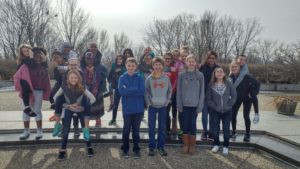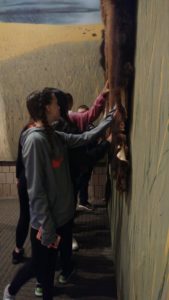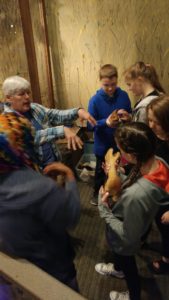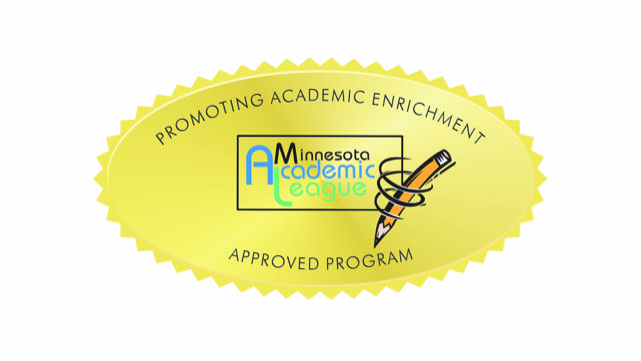By YES! Central Coordinator Erin Nordquist
On February 27th, 2017, 22 students and teachers from Youth Energy Summit (YES!) teams at Melrose Middle School and North Jr High attended the Back to Our Roots Winter Workshop at the Stearns History Museum and Quarry Park. This workshop guided students through a pre-settlement Stearns County to highlight land use changes in the area and provided historical context for their habitat centered projects. 
The students started the day at the Stearns History Museum where they learned about the natural history of the county and got a peek at how it used to look before significant human impact. It was important for the teams to see just how much of an impact humans have made on their local environment to get a good sense of why their projects are essential. Julianne O’Connell, museum curator, made it clear to the students that they are a part of history, whether they want to be or not! It’s something that we may take for granted, but the decisions that we make and the actions that we take will always influence our environment and affect the history of the area.
After the museum, the group took a trip to Quarry Park and Nature Preserve. Ben Anderson, Park Operations Coordinator for Stearns County, spoke to the students about the history of Quarry Park, the granite quarrying process, and some of the projects that have been done to restore the natural habitats within the park. Several staff from the Prairie Woods Environmental Learning Center (PWELC) then brought the group on a hike which included some stops to talk about the habitats represented in the park or play games to learn about ecological interactions. One of these games is called “Oh Deer!” and it demonstrates how availability of resources in a habitat affects the population numbers of wildlife.
All of the activities that the group participated in were particularly helpful because both teams that attended the workshop are currently undertaking projects designed to help resolve habitat issues that have been caused by the human footprint.
 The Melrose team is building bat boxes to install in their community in order to create habitat for the Northern Long-Eared bat. As mentioned in a previous blog, this bat species was recently listed as threatened on the endangered species list due to a fungal disease called the White-Nose Syndrome. Human interaction with the bats’ natural habitat has amplified the spread of the disease, but bat boxes can help provide a disease-free shelter for the bats to survive the winter.
The Melrose team is building bat boxes to install in their community in order to create habitat for the Northern Long-Eared bat. As mentioned in a previous blog, this bat species was recently listed as threatened on the endangered species list due to a fungal disease called the White-Nose Syndrome. Human interaction with the bats’ natural habitat has amplified the spread of the disease, but bat boxes can help provide a disease-free shelter for the bats to survive the winter.
The North Jr High team is planting a 1.3 acre native prairie on their school grounds that is specifically for pollinators. With the loss of habitat to urbanization, which needs to include flowers as a food source and tall grasses for nesting, pollinator numbers have dropped significantly in recent years. The team has chosen a wide range of plants with varied blooming times and colors to support the survival of as many pollinator species as they can.
